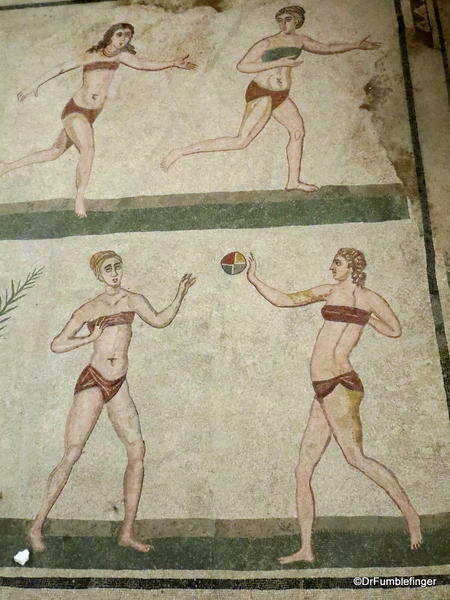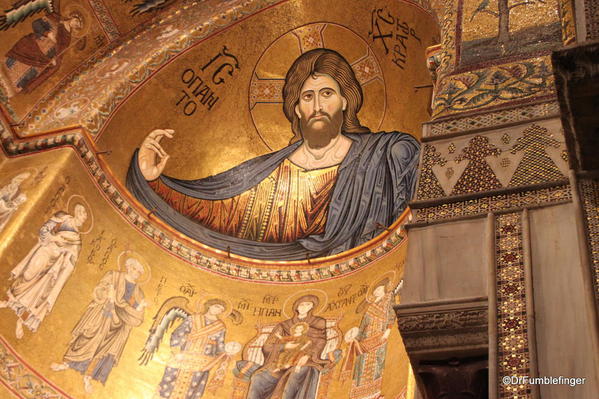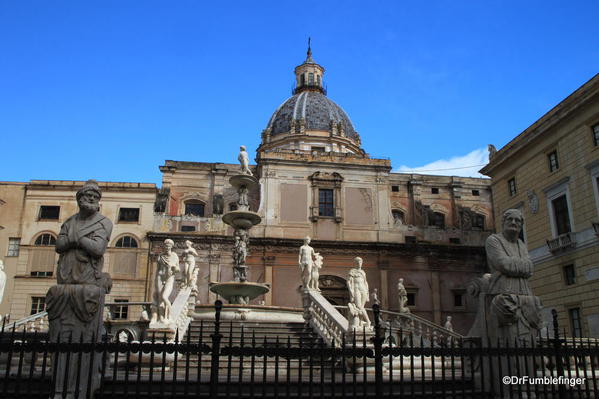Travel guru Rick Steves likes to say (and I'm paraphrasing) that Italy either gets better or worse as you head south from Rome, depending on what you like. If you like a quieter people, trains running almost on time, etc. head north towards Milan. If you enjoy a lively chaotic experience, perhaps a little rough around the edges, then head to the bottom of the boot. Sicily, the three cornered island just a few miles from the mainland is about as far south as you can go. It's part of Italy, but really has its own unique history and heritage.
(Old Gate, Palermo)
I'd wanted to go to Sicily to meet its people, enjoy its food, and experience its antiquities and heritage. I knew of its superb collection of preserved Greek relics -- more temples surviving here than anywhere else. I knew a little about the Arab-Norman architecture around Palermo and the Baroque architecture in the southeast, but I learned a lot about Sicily during my trip preparation and our 2 weeks stay on the island.
(Palermo Cathedral, built in the Arab-Normal Style)
Sicily is the largest Island in the Mediterranean, with the Tyrrhenian Sea to the north, the Ionian Sea to the east, and the Mediterranean Sea to the south. It is strategically located between Africa and Europe and has been influenced by cultures from both regions. These waters were navigated by the powerful nations of the past few millennia, many of whom conquered and plundered Sicily.
In sequence, the following societies were victorious over the Sicilians (and it's not even a complete list):
(Ancient catacombs, Syracuse)
- Greeks, who left a tremendous heritage on the island. Apparently Sicily has more surviving Greek temples than Greece.
(800 year old olive tree and the Concord Temple, Agrigento)
(Greek Theater in Syracuse)

(Roman mosaics at Villa Romana Del Casel, Sicily)
- Romans. Sicily was one of Rome's first colonies and for 800 years was an important source of food and money for the Roman empire (it has been called the "bread basket of Rome"). Unlike many of their outposts, relatively few Roman ruins are to be found.
(Roman mosaics at Villa Romana Del Casel, Sicily)
(Roman theater, Segesta)


- Byzanthines, whose artistry and wonderful mosaic work outlived their time as conquerors.
- Arabs of North Africa. Their influence is best seen in Palermo, a city which thrived during their rule. They invested heavily in construction and had a major influence on the Normans, who subsequently defeated them. The Arabs introduced finely made gardens, palaces, mosques, colored ceramics and ceiling paintings.
(Abbey at Monreal Cathedral, said to be the
best existing example of Arab-Norman design)
- Normans. Sicily thrived under Norman rule and was actually one of the richest regions of Europe at this time. The Normans altered the Arab buildings, and added Romanesque forms. The Arab-Norman hybrids are some of Sicilia's most unique structures and a number of them just received UNESCO World Heritage status.
- Spaniards: Financially drained Sicily and added little of island. The Spanish were largely absentee landlords.
(Fontana Pretoria, Palermo. 16th century fountain)
- Remarkably Sicily was the only part of Italy not invaded by Napoleon, but it did capture Hitler's attention and some nasty battles were fought in Sicily before it was liberated from Nazi rule.
- Add to this the negative influence of the Mafia in the 20th century and you can understand why many Sicilians don't trust or like government and authority.
So Sicily has been influenced by many nations and many cultures in its past, and has generally been left poorer as a result. The island is starting to emerge with agriculture and especially tourism providing important pillars of economic strength. Unemployment is still much to high, around 20%, but Sicilians have a sense that things are improving.
Sicily escaped the influence the Renaissance had on the rest of Italy, but it had a huge Baroque influence that lingers to this day. This is in large part because of a devastating earthquake in 1693 in the southeastern part of the island that completely flattened many towns. The rebuilding of these places had a "Sicilian Baroque" theme which you can enjoy to this day.
(Duomo in Catania, classic Sicilian Baroque)
(Duomo in Modica, another example of Sicilian Baroque)
Sicily is surprisingly mountainous, many of these mountains being steep and tall, with beautiful scenery. Only 14% of the island is flat and it's here you'll find great olive, almond and citrus orchards, and vineyards. Sicily has Europe's most active volcano, Mt. Etna, (10,900'). whose eruptions make the island prone to earthquakes. The volcanoes occupies much of the northeastern part of Sicily.
(Hills around Segesta)
(Hill town of Ragusa Ibla)
There is fascinating art and architecture and a unique culture. There's lots to do in the outdoors, like hiking, swimming, diving and mountain climbing. Because of the hilly landscapes, there are only a few reliable train routes and the best way to see the country is with a rented car, as we did. It's climate is Mediterranean.
Like the rest of Italy, Sicily has great food and wine, which we'll discuss in greater detail in future posts....
(Pasta con le Sarda, made with sardines, fennel, pine nuts and caper -- delicious!)
(Pasta alla Norma, a Catanian dish named after Bellini's opera, Norma,
crafted to look like the snow covered volcano, Mt. Etna)
(Catania's famous fish market)
The people are friendly and outgoing... Sicilians are stoic and very family oriented. They are great hosts and enjoy meeting new friends. English is widely spoken in the larger cities, but much less so in smaller towns and villages.
If you want to see all the regions of Sicily, you'll likely need at least a three week visit. While the island is small, there's a lot to see and do, and it's not possible to get around quickly.
In the coming weeks I'll be sharing some of my experiences and observations on Sicily, a listing of which you can find here.

Comments (0)